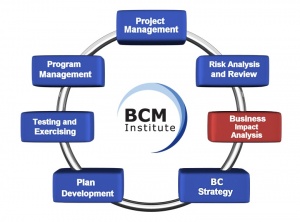Difference between revisions of "Part 3: Impact Over Time of Business Functions v2.0"
Jump to navigation
Jump to search
| Line 14: | Line 14: | ||
**Example of a typical entry is “1” if the time scale is less than 4 hrs, “2” if less than 1 day. Refer to the scale found in Part 2. | **Example of a typical entry is “1” if the time scale is less than 4 hrs, “2” if less than 1 day. Refer to the scale found in Part 2. | ||
| − | == | + | ==[[Recovery Time Objective (RTO)|'''Recovery Time Objective (RTO)''']] (Col 17 to 18) == |
* Sometimes referred to as Disaster Timescale or Crisis Timeline | * Sometimes referred to as Disaster Timescale or Crisis Timeline | ||
*During a disaster, would you be able to stretch the timescale during the delivering of this business function? Would your customer be able to bear with the delay? | *During a disaster, would you be able to stretch the timescale during the delivering of this business function? Would your customer be able to bear with the delay? | ||
Revision as of 12:15, 26 January 2020
Part 3: Impact Over Time of Business Functions
Business Function and Function Code (Col 2 & 3)
- Cross-reference to the Business Function/function code or number from original Function No assigned in Part 1
Highest Impact Area (Col 4)
- Highest-Impact Area refers to the impact area determined during Impact analysis in part 2 of the BIA
Impact Over Time (Col 5 to 16)
- The timescale for a business function to be carried out on a normal day. You can consider it as to how long does it takes to do one transaction. Insert the appropriate timescale found in the BIA Questionnaire.
- Example of a typical entry is “1” if the time scale is less than 4 hrs, “2” if less than 1 day. Refer to the scale found in Part 2.
Recovery Time Objective (RTO) (Col 17 to 18)
- Sometimes referred to as Disaster Timescale or Crisis Timeline
- During a disaster, would you be able to stretch the timescale during the delivering of this business function? Would your customer be able to bear with the delay?
- Please make a personal judgment based on a “credible” Worst Case Disaster Scenario.
- Could the business function be carried out over a longer period, possibly by using different means during a disaster?
- Assume it is not possible to access your office location.
Maximum Tolerable Period of Disruption (MTPD) (Col 19 to 20)
- Maximum Tolerable Period of Disruption or MTPD/MTPoD is the maximum allowable time that the organization’s key products or services is made unavailable or cannot be delivered before its impact is deemed as unacceptable.
Vulnerable Period (Col 21)
- State the specific time e.g.
- Month-end
- Year-end
- 25th of month
- 4.30 pm daily
- Not applicable
etc. whereby the business function is most vulnerable.
- Notes (1): Try to discourage answers such as “All day” and “Ad-hoc.” Additionally, try to give a definitive date instead of a range. For example, no 5 to 7 days
- Notes (2): The key is to identify how much time it takes to complete a transaction and compare this with the time to be taken during a disaster.


